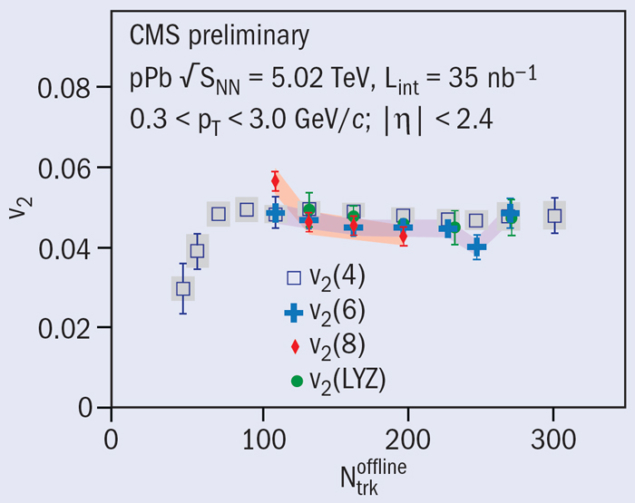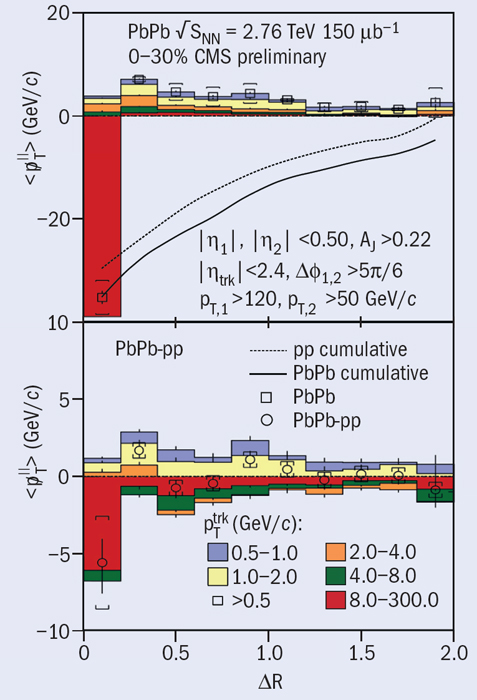

Although the CMS experiment was designed primarily for precise measurements in proton–proton (pp) collisions, in recent years it has demonstrated exceptional capabilities in studying interactions of heavy nuclei. At Quark Matter 2014, the CMS collaboration presented a wealth of new results from their heavy-ion physics programme. The most recent analyses focus on collisions of protons on lead ions (pPb), delivered by the LHC in early 2013.

At the forefront of such studies, CMS continues its investigation of the surprising “ridge phenomenon”. This long-range particle correlation had previously been observed in nucleus–nucleus (AA) collisions and is interpreted as evidence of the hydrodynamic expansion of the quark–gluon plasma (QGP) created in these collisions. Lighter collision systems such as pp and pPb were not expected to produce a dense enough environment to produce such a flow effect, which is thought to arise from the fluid-like behaviour of the QGP. Nevertheless, a similar correlation was observed in collisions with high particle multiplicity in both systems (CMS collaboration 2013).
Previous measurements focused mainly on correlations between particle pairs. However, it is important to address whether the ridge observed in pPb collisions is really collective in nature, and this can be achieved by looking into correlations among a larger number of particles. Flow effects are measured typically by looking at the azimuthal anisotropy of particle momenta using a Fourier decomposition. Figure 1 shows the magnitude of the second Fourier harmonic (v2), as a function of total particle multiplicity, extracted using a multiparticle cumulant expansion, as well as using Lee–Yang zeros, a technique that probes the correlations among all particles in the event. That v2 shows little dependence on the number of particles used in the correlation supports the interpretation of long-range correlations as a collective effect.

Further insight into long-range correlations might be gained by exploring their “hadro-chemistry”. The CMS silicon tracking system is well suited to identifying hadrons that contain strange quarks, such as the K0s meson and Λ baryon, via their decay topologies. Figure 2 (left) shows a clear dependence on species when comparing v2 for K0s, Λ and non-identified charged particles in high-multiplicity pPb events. Within about 10–15%, the data (figure 2, right) are found to obey a scaling relation first seen in AA collisions, whereby the v2 per constituent quark is independent of particle species for the same transverse kinetic energy per constituent quark. In AA collisions, such a scaling is typically interpreted as evidence of flow developed at a very early time, before the quarks combine into final-state hadrons.
In addition to their role in elucidating collective effects in small systems, pPb collisions serve as an important reference for phenomena observed in PbPb collisions. Observables intended to probe the QGP might also be influenced by the initial state of the colliding nuclei. Nuclear effects on the parton distribution functions (PDFs) can be constrained with pPb collisions, i.e. in the absence of an extended QGP final state.
Shortly after the first pPb collisions were recorded, CMS demonstrated sensitivity to nuclear effects on the PDFs via a measurement of the dijet rapidity shift (CMS collaboration 2014). In addition to jets, electroweak bosons are excellent observables for studying PDFs, because their production can be calculated precisely and they can be measured to high precision, given sufficient data. For the rapidity range measured by CMS, the production of Z bosons is sensitive to the parton distributions at large Q2 and Bjorken x in the range 10–3–10–1, a kinematical region that is largely unexplored by previous measurements.
In analysing the 2013 pPb data, the collaboration found more than 2000 Z bosons via their decays to muon pairs. Figure 3 shows the ratio of Z production at forward and backward rapidity in pPb collisions, where forward is the direction of the incident proton. The data are compared to next-to-leading order perturbative calculations produced with the MCFM generator, without and with the nuclear modifications to the parton distributions expected for two different parameterizations of nuclear effects (EPS09 and DSSZ). The data show an indication of the forward–backward asymmetry expected from these calculations. In conjunction with Z boson measurements in the electron channel, as well as other observables such as photons and W bosons, LHC data will soon begin to dominate knowledge of the nuclear parton distributions in some regions of x and Q2.
In addition to the pPb studies, CMS continues to perform increasingly detailed studies of the jet-quenching phenomenon, which gives rise to the striking dijet pT asymmetries observed in PbPb collisions (CMS collaboration 2011). Tracing the fate of energy lost by hard-scattered partons in the dense QGP remains a fascinating challenge for the field. To investigate this in more detail, CMS looks at correlations of charged particles with asymmetric dijets in central collisions. To avoid sensitivity to the bulk of particle production, which is largely unrelated to the jets, the vector sum of the transverse momenta with respect to the dijet axis is considered. This “missing pT” is shown in figure 4 (top) as a function of the radial distance from the jets in central collisions for all charged particles, as well as individually for different ranges of pT, for the 30% most central PbPb collisions. The missing-pT analysis allows the first detailed study of the angular dependence of the momentum balance up to large distances from the jet axis (ΔR = 1.8). By evaluating the difference with respect to the same distribution from pp collisions (figure 4, bottom), the angular pattern of the energy flow is shown to be comparable, although it exhibits a large shift in the momentum spectrum of radiated particles in PbPb collisions. The pattern of energy flow provides the most direct window into the dynamics of the jet–QGP interaction observed yet.
The results summarized here represent only a small fraction of the new results from CMS presented at Quark Matter 2014. All the latest CMS heavy-ion results can be found at https://twiki.cern.ch/twiki/bin/view/CMSPublic/PhysicsResultsHIN.
Further reading
CMS collaboration 2013 Phys. Lett. B 724 213.
CMS collaboration 2014, arXiv:14014433v1, submitted to EPJC.
CMS collaboration 2011 Phys. Rev. C 84 024906.





